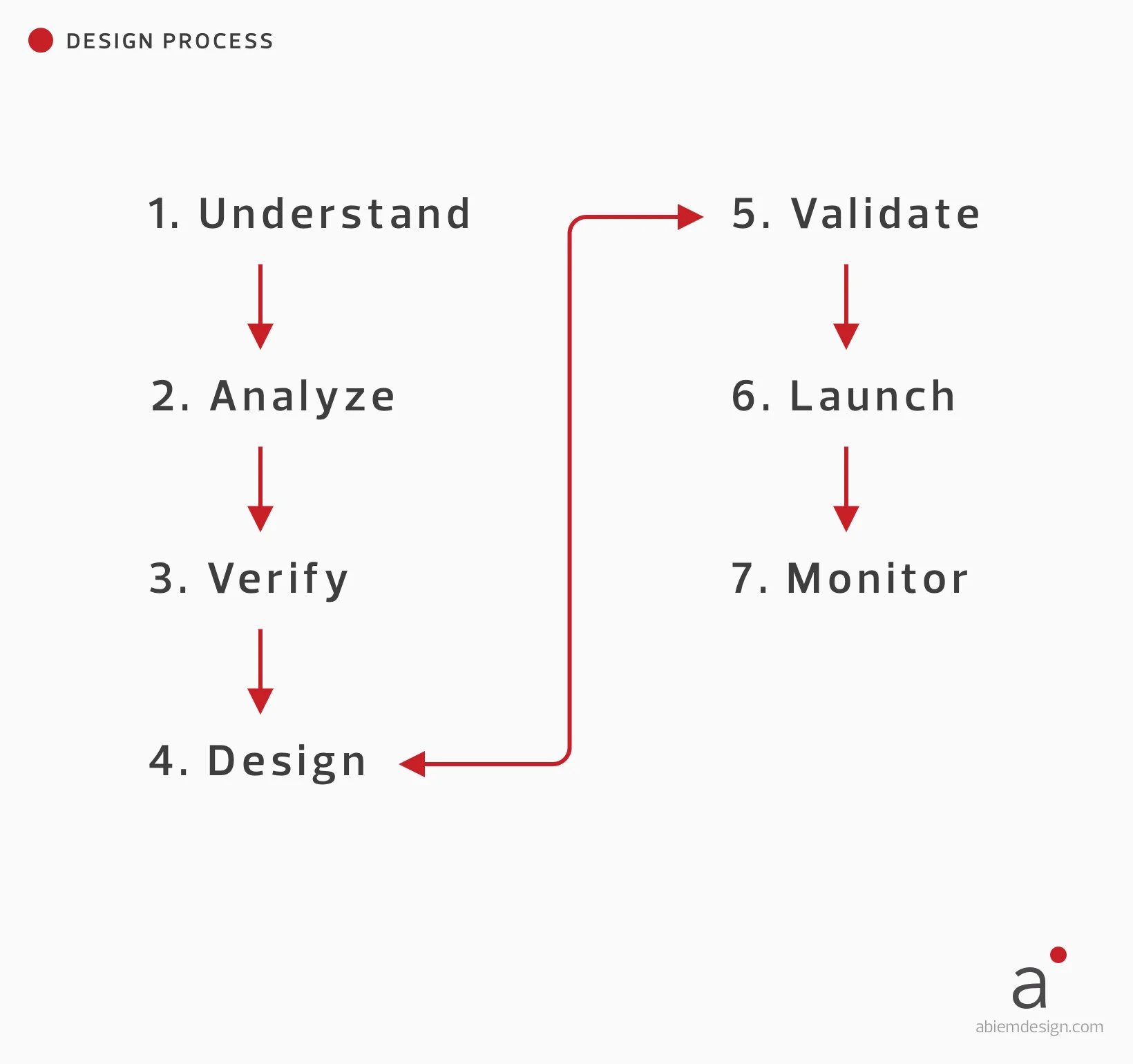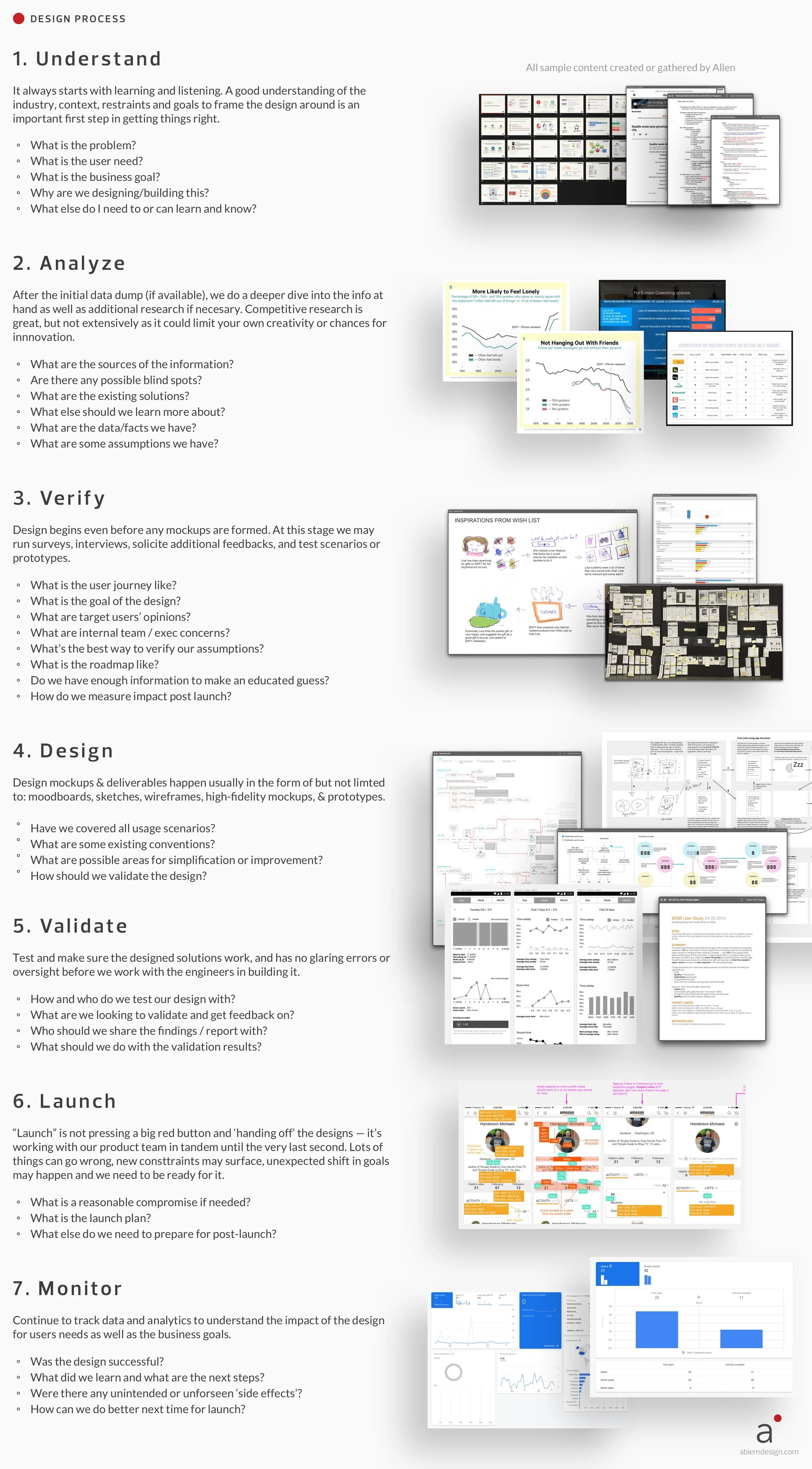“One thing I’ve mastered over the years aside from solving for ambiguity, is the ability to synthesize information from all sources and figuring out an ideal path forward with the team.“
How I think about design.
“Design” sounds fancy and has many definitions, but it can be thought of as simply the action and result of a process used to find the best solution. At a high level, I believe design has 2 simple goals:
Serving the end-user (consumer/customer)
Enabling the business
The former is what will validate the design, and the latter is what the design will enable and empower. A design that cannot be built or executed to serve the end user, or connect to business goals, becomes just a form of expression, almost like art.
My design process & strategy.
In a perfect scenario, any design would go through a process where there’s ample time at every stage, enough data points and input to support decisions, enough resources to enables the ideal outcome, and time to revisit and improve everything. Of course real-world scenarios are often the complete opposite and (especially in a consultancy environment) often forces us to internalize some of the steps. At a high level it this is how I approach my design strategy.
Diving in deeper, after many years of execution on different products and environments, I’ve mastered a way to go through this process as efficiently as possible at an amazing pace — whether on my own or leading a team through it together.
The design process is always a race against time, so the ‘best solution’ is not an ideal one, but one that is carefully crafted, balanced, and thoughtfully delivered to fulfill a goal or purpose in order to propel the business forward.
Managing & supporting teams.
Whether it’s leading a project, building & managing my own team, or collaborating with other teams, there are a few foundation pillars I strongly believe in and live by. As a team goes through its different stages more structure comes in place, higher efficiency is achieved, and ultimately full-autonomy can happen with practice.
To be a great leader it is essential to have the ability to:
Earn trust
Support & empower
Uphold standards (and keep raising the bar)
Be accountable (deliver results)
I believe learning by diving in deep and experiencing (and practicing) is the quickest way to get really good at something. I apply this belief when leading my team, giving them ownership, hands-on experience, and enough buffer to learn how they can start and improve during the process. I first lead by example, but hand-off to the team as soon as possible once they are well-prepared for the project and task.
My tenets in managing a team are
The environment and culture should be collaborative, positive, and confident.
All members (designer or not) should be purposeful, and always keep an eye on the bigger picture — whether it’s the experience, the feature, or the process.
Achieve autonomy as soon as possible.
PASSION vs SKILL
Having passion for an assigned task and also having the right skills for it are ideal — but in choosing the 2, I often opt for strong passion in team members or candidates. With passion and interest, individuals will pick up the required skills and figure out ways to get it done. However, with ample skills but not enough drive, the task will become stagnant and unenjoyable.
STRUCTURE vs SPEED
These 2 are one of the hardest things to balance in a team and organization. Moving too fast can cause chaos, especially for new projects or new members. However having too much process and structure may slow things down drastically (although sometimes improving results as well).
My guiding principals are that we need to introduce more structures if it:
Unblocks the team in any way
Enhances productivity drastically
Moves the team closer to autonomy
Distribute ownership but have 1 voice
As a team progresses from the Storming stage to Norming, more ownership needs to be distributed as it allows the team to continue to scale up, mature, and build deeper expertise in their area of ownership. As ownership gets distributed it becomes increasingly important for the leaders to be aligned on purpose, team identity, and goal. By being aligned and having a “1 voice” it ensures consistency inside and outside the team, avoids confusion, and helps onboard new resources to the team.
Working with clients.
When working with internal or external clients my first priority is always to enable the business. Personal priorities and preferences cannot hinder the business objective as it is the sum of the whole. Second priority is to always protect the team, to ensure we foster an environment where team members can confidently own, execute, and support each other to perform their best work.
Through years of managing stakeholders in various environments I’ve designed a path in working with clients to make relationships positive, lasting, and valuable for both parties.








